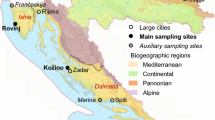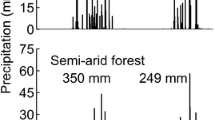Abstract
The surface-area-to-volume ratio (SAV) is a significant parameter in vegetation description, although different researchers have presented diverging estimates for forest litter. However, considering litter as a unique entity and disregarding the SAV of its components provides a misleading fire rate of spread. Undoubtedly, the leaves are more relevant than the twigs for the rate of spread of surface fires, as the former has a higher SAV. Therefore, based on the proven hyperdominance of tree species in the Brazilian rainforest, this work presents an accurate method to estimate the SAV. Furthermore, it demonstrates the critical role played by the SAV in the litter flammability and fire rate of spread assessments and shows that the leaf moisture content does not influence its SAV. Besides, comparing SAV data using the methodology presented herein with other authors’ assessments, the results differ by up to 49%. Finally, using the Brazilian rainforest litter in the methodologies of two distinct authors showed a difference of at least 36% in the results. The primary outcome of this study is the estimation of the SAV of leaves and thin, medium, and thick twigs, representative of the Brazilian rainforest, at 12,680 m−1, 1360 m−1, 620 m−1, and 310 m−1, respectively. The estimated SAV values are essential input data to numerical simulation models, and for comparison purposes with other authors’ work, the litter SAV is 8460 m−1.






Similar content being viewed by others
References
Vogel S (1998) Life’s devices: the physical world of animals and plants. Princeton University Press, Princeton, pp 38–42
Fernandes PM, Rego FC (1998) A new method to estimate fuel surface area to volume ratio using water immersion. Int J Wildland Fire 8:121–128
Papió C, Trabaud L (1990) Structural characteristics of fuel components of five Mediterranean shrubs. For Ecol Manag 35:249–259
Engber EA, Varner JM (2012) Patterns of flammability of the California oaks: the role of leaf traits. Can J For Res 42:1965–1975. https://doi.org/10.1139/x2012-138
Rothermel RC, Anderson HE (1966) Fire spread characteristics determined in the laboratory. USDA Forest Service, Intermountain Forest and Range Experiment Station, Research Paper INT-30, Ogden, UT
Rundel PW (1981) Structural and chemical components of flammability. In: Mooney HA, Bonnicksen TM, Christensen NL, Lotan JE, Reiners WE (eds) Proceedings of the conference on fire regimes and ecosystems properties. USDA Forest Service, General Technical Report WO-26, Honolulu, HI, pp 183–207
Ottmar RD (2014) Wildland fire emissions, carbon, and climate: modeling fuel consumption. For Ecol Manag 317:41–50
Rothermel RC (1972) A mathematical model for predicting fire spread in wildland fuels, USDA Forest Service, Intermountain Forest and Range Experiment Station, Research Paper INT-115, Ogden, UT
Andrews P, Bevins CD, Seli RC (2009) BehavePlus fire modeling system, version 5.0: user’s guide. USDA Forest Service, Intermountain Forest Rocky Mountain Research Station, General Technical Report RMRSGTR-106WWW, Ogden, UT
WFDS (2018) Web page for the WFDS model. http://www.fs.fed.us/pnw/fera/research/wfds/index.shtml. Accessed 07 Jan 2019
Mell WE, Maranghides A, McDermott R, Manzello S (2009) Numerical simulation and experiments of burning Douglas fir trees. Combust Flame 156:2023–2041
Bufacchi P, Krieger GC, Mell W, Alvarado E, Santos JC, Carvalho JA Jr (2016) Numerical simulation of surface forest fire in Brazilian Amazon. Fire Saf J 79:44–56. https://doi.org/10.1016/j.firesaf.2015.11.014
Bufacchi P (2014) Simulação numérica de incêndios de superfície na região amazônica com modelo de turbulência de grandes estruturas. PhD Thesis, Department of Mechanical Engineering, University of São Paulo, São Paulo, Brazil
Sullivan AL, Surawski NC, Crawford D, Hurley RJ, Volkova L, Weston CJ, Meyer CP (2018) Effect of woody debris on the rate of spread of surface fires in forest fuels in a combustion wind tunnel. For Ecol Manag 424:236–245
DeLuca TH, Boisvenue C (2012) Boreal forest soil carbon: distribution, function and modelling. Forestry 85(2):161–184
Scott JH, Burgan RE (2005) Standard fire behavior fuel models: a comprehensive set for use with Rothermel’s surface fire spread model. Gen. Tech. Rep. RMRS-GTR-153. U.S. Department of Agriculture, Forest Service, Rocky Mountain Research Station, Fort Collins, CO
Brown JK (1970) Ratios of surface area to volume for common fine fuels. For Sci 16:101–105
Mauseth JD (2000) Theoretical aspects of surface-to-volume ratios and water-storage capacities of succulent shoots. Am J Bot 87:1107–1115
Hachmi M, Sesbou A, Benjelloun H, Bouanane F (2011) Alternative equations to estimate the surface-to-volume ratio of different forest fuel particles. Int J Wildland Fire 20:648–656
Ter Steege H, Pitman NCA, Sabatier D et al (2013) Hyperdominance in the Amazonian Tree Flora. Science 342:1243092. https://doi.org/10.1126/science.1243092
Acknowledgements
Partial funding for this work was received from the São Paulo Research Foundation (FAPESP) Programs under Projects 2008/04490-4 and 2011/20679-2.
Author information
Authors and Affiliations
Corresponding author
Ethics declarations
Conflict of interest
The authors declare that they have no conflict of interest.
Additional information
Technical Editor: Mario Eduardo Santos Martins, Ph.D.
Publisher's Note
Springer Nature remains neutral with regard to jurisdictional claims in published maps and institutional affiliations.
Rights and permissions
About this article
Cite this article
Bufacchi, P., Santos, J.C., de Carvalho, J.A. et al. Estimation of the surface area-to-volume ratios of litter components of the Brazilian rainforest and their impact on litter fire rate of spread and flammability. J Braz. Soc. Mech. Sci. Eng. 42, 266 (2020). https://doi.org/10.1007/s40430-020-02303-8
Received:
Accepted:
Published:
DOI: https://doi.org/10.1007/s40430-020-02303-8






